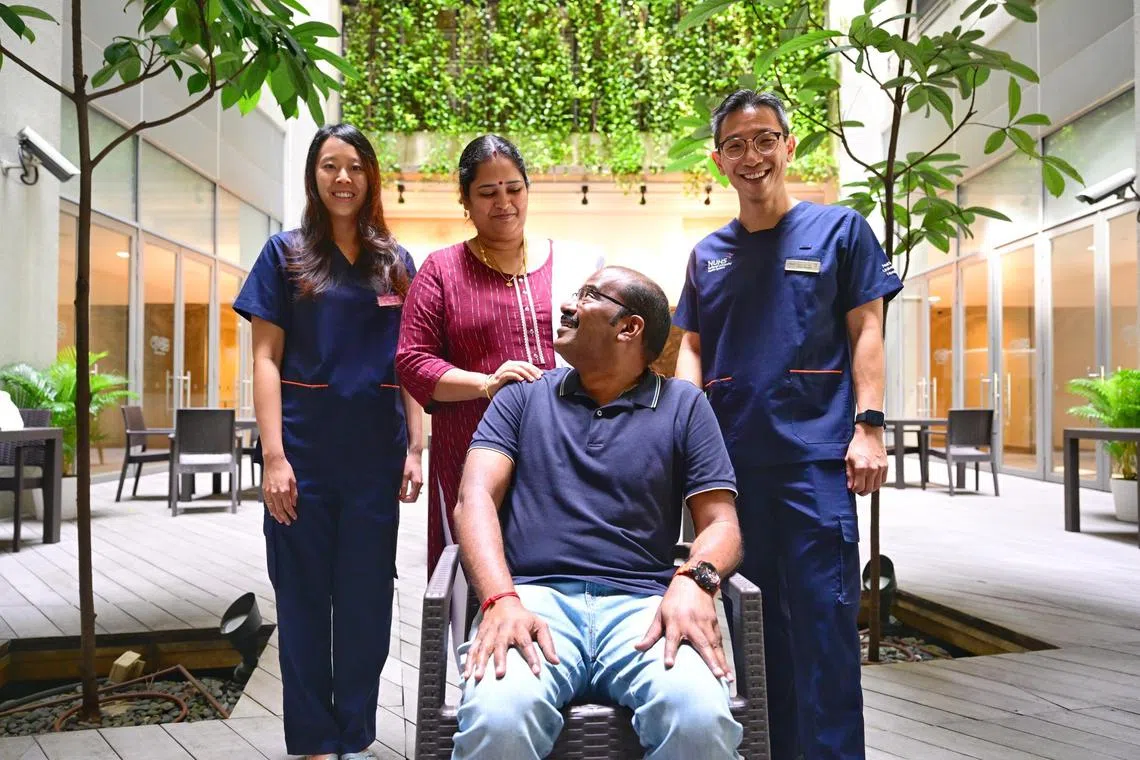NUH surgeons use mouth tissue to mend man’s ureter in novel surgery
Sign up now: Get ST's newsletters delivered to your inbox

Dr Melissa Tay and Associate Professor Tiong Ho Yee from NUH, who performed the surgery, with Mr Kathavarayan Dhinakaran and his wife Arivunila Dhinakaran.
ST PHOTO: AZMI ATHNI
SINGAPORE - Surgeons from the National University Hospital (NUH) have successfully carried out a novel surgical procedure to preserve a man’s kidneys, by repairing his ureter using tissue from inside his mouth.
The ureter is a tube that carries urine from the kidney to the bladder.
At a media briefing on Dec 7, Associate Professor Tiong Ho Yee, senior consultant at NUH’s department of urology, and Dr Melissa Tay, a consultant in the same department, said they performed the four-hour surgery in September 2022 using a surgical robot, in what they believe is a first in Singapore.
They announced it more than a year after monitoring the results of the operation, as the graft is less likely to fail after a year.
The technique was first documented in a paper published in urology medical journal European Urology by doctors from the United States in November 2017.
The patient, Mr Kathavarayan Dhinakaran, had surgery in India when he was 21 to remove a blockage at the ureteropelvic junction – where the kidney meets the ureter.
This slows or stops the flow of urine out of the kidney, leading to swelling of the kidney.
Then in November 2021 in Singapore, Mr Dhinakaran was hit by a bout of excruciating pain on the right side of his body.
“I was in so much pain I could not lie down. I also vomited a few times,” said Mr Dhinakaran, who is now 46 and a senior engineer at an oil and gas company.
The next morning, he went to NUH’s emergency department and was referred to the urology department.
Doctors found that his right ureter had narrowed as a result of scar tissues at the site of his first surgery.
The condition is known as ureteral stricture, which can lead to urinary infections, stones and kidney problems.
Mr Dhinakaran underwent an endoscopic balloon dilation, where a balloon is inserted at the site of the obstruction to stretch it open.
But his symptoms persisted, complicated by stones and urinary tract infections. His right kidney was contributing 30 per cent of his total renal function.
A person with two healthy kidneys would have each kidney performing 50 per cent of the organs’ full functions.
After the two failed procedures, more surgery became more challenging with the presence of scar tissues.
Surgeons then turned to a different method, called buccal mucosa pyeloplasty, to help him.
It involves harvesting the lining of the cheek, known as buccal mucosa, before the operation.
The narrowed part of the ureter is then cut open and patched with the harvested tissue using minimally invasive robotic surgery.
To ensure the grafted tissue receives enough blood supply, the omentum, or a membranous layer of fatty tissue that supports the organs in the lower abdominal area is stitched onto the patched portion.
Dr Tay said the buccal mucosa is the perfect tissue to use to repair the ureter.
She said: “A small piece of mucosa can actually be stretched and lengthened, so you don’t need the exact length. The mouth is exposed to saliva, which is also the same kind of wet and moist conditions in the urinary system.”
Prof Tiong said the main advantage of this technique is that it is an elegant solution that spares the patient from a more difficult and riskier operation that requires open surgery.
He said: “In recent times, the management of ureteral strictures has evolved from open repair to laparoscopic and robotic techniques, which lead to shorter healing time and better surgery outcomes for patients.”
Laparoscopy is an operation performed in the abdomen or pelvis using small incisions with the aid of a camera.
The surgeons said the new technique can be used on patients who suffer from ureteral strictures due to factors such as surgery, radiation and endometriosis, where tissue similar to the lining of the uterus grows outside it.
More than a year after the surgery, Mr Dhinakaran has recovered well.
“I’m happy because I’m able to do normal activities like go back to work, and walk and cycle,” he said.
Costs for a five-day stay for a subsidised patient undergoing this type of surgery will start from $6,000, while a private patient at NUH can expect to pay at least $37,000.
Prof Tiong estimated that NUH sees about 30 complex ureteral strictures a year that may require more than one surgical procedure to resolve.


